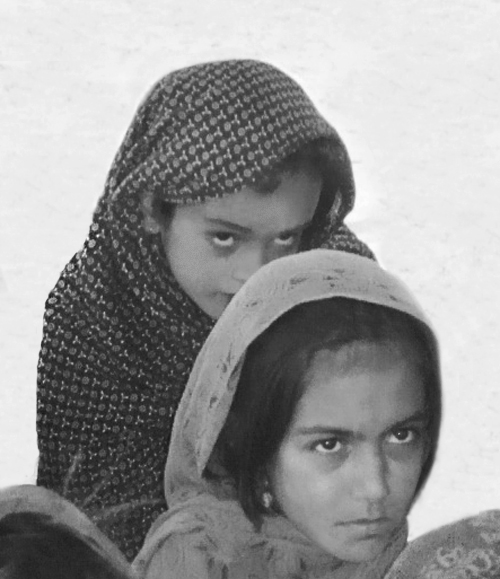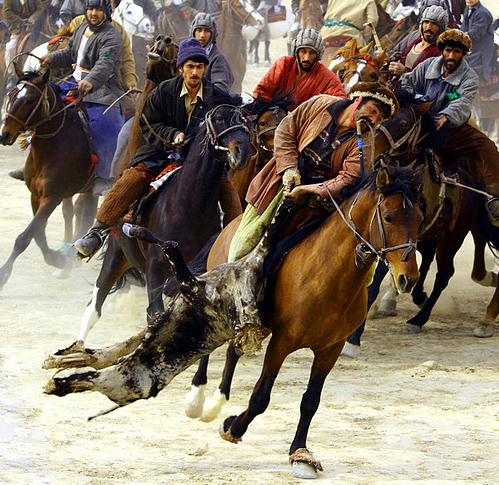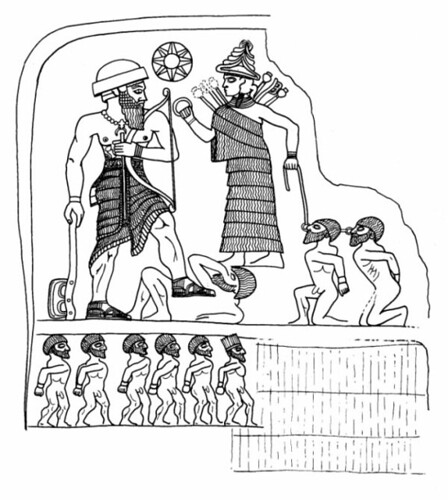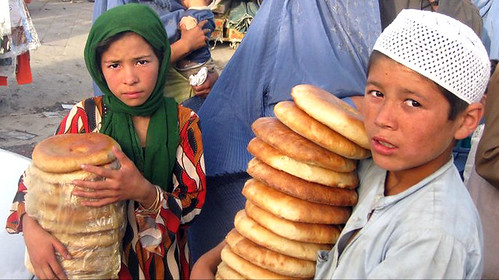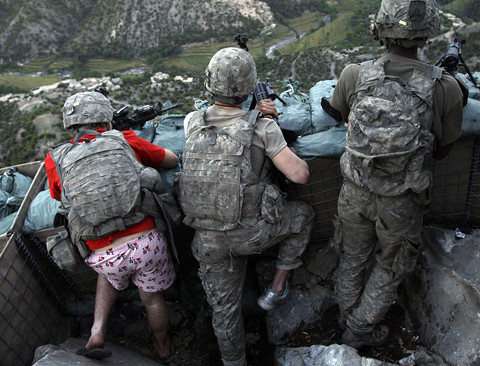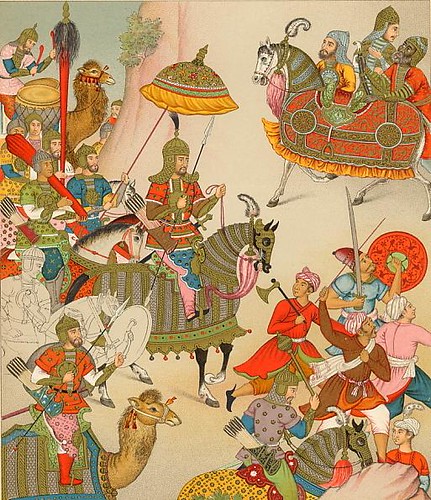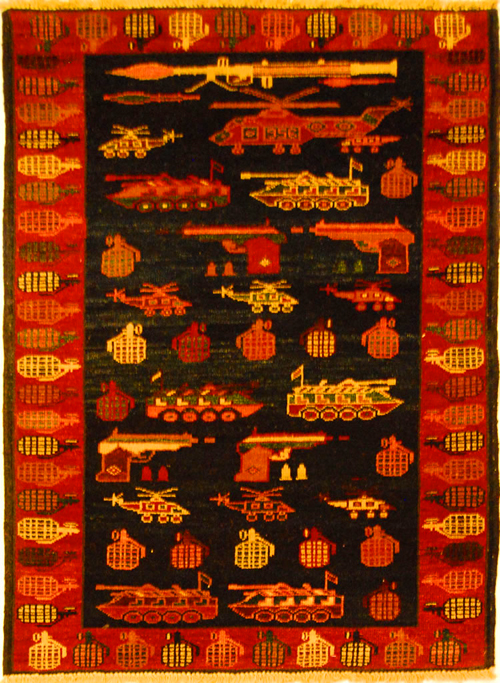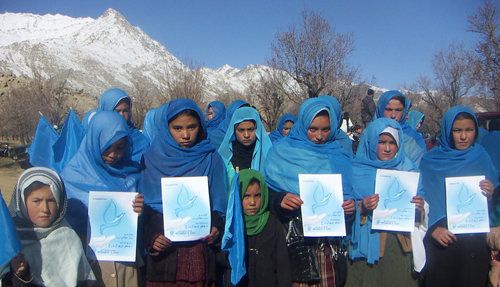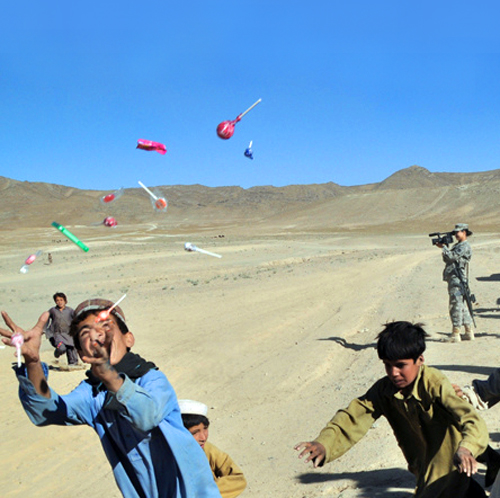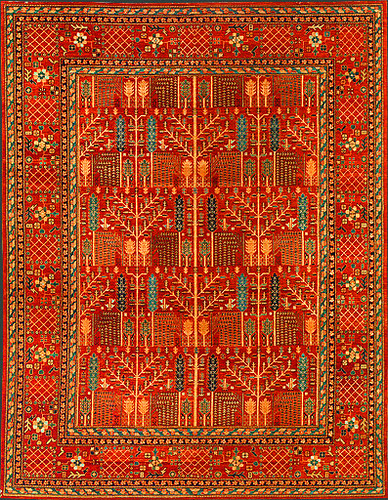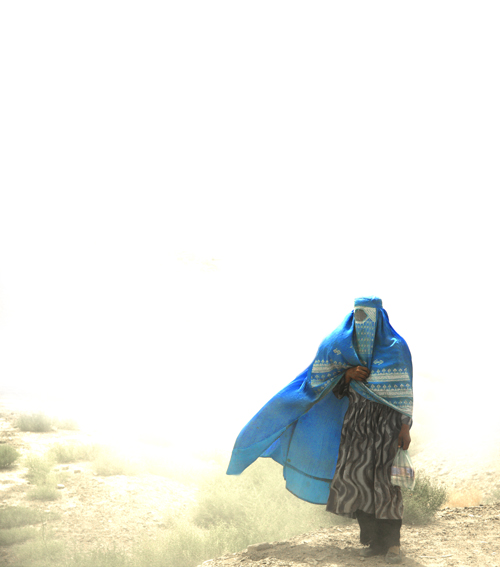
Sandstorm in Balkh Province, Afghanistan
Tag: Afghanistan
Dec 15 2010
Sandstorm and Snooki
Dec 14 2010
Selling Children For US “Success” in Laghman Province
Nine-year-old Khalida Shah was eventually sold in Jalalabad, but her transformation into collateral began in Laghman Province, where her father pledged his poppy crop for a $2000 loan, and when those poppies were eradicated in a successful episode of America’s unending War on Drugs, Khalida became a “bride” of the 45-year-old creditor.
“It’s my fate,” the child says.
Dec 13 2010
“Nothing is true. Everything is permitted.”
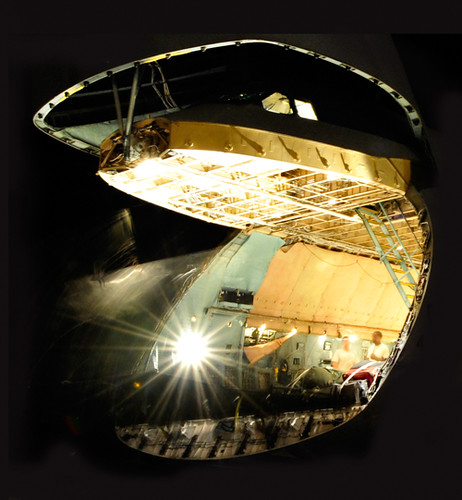
Forward loading bay of a C-5B at “Camp Marmalade” in Mazar-i Sharif
The city of Mazar-i Sharif was created because a local mullah dreamed that the first Shia Imam was buried there, and after another weird quirk of fate, more than 5000 NATO soldiers are now stationed at nearby Camp Marmalade.
Aircraft based at Camp Marmalade provide close air support for NATO operations all over northern Afghanistan, like the airstrike which killed ten people in Takhar Province on September 2, 2010.
President Hamid Karzai said the victims were campaign workers seeking votes in this month’s parliamentary elections.
Earlier, Takhar Gov. Abdul Jabar Taqwa said the car in which candidate Abdul Wahid Khorasani had been riding was fired on by helicopters following an initial pass by fighter jets. He called the incident an obvious mistake, saying there were no Uzbek militants, foreigners or members of the Islamic Movement of Uzbekistan in the convoy.
“There aren’t even any Taliban in this area,” Taqwa said. “They were all working on Mr. Khorasani’s campaign.”
NATO predictably denied all charges even from its own allies in Takhar Province.
After careful planning to ensure no civilians were present, coalition aircraft conducted a precision airstrike on one sedan and later followed with direct fire from an aerial platform. The vehicle was traveling as part of a six-car convoy, but no other vehicles were hit in the strike,” the military said.
But instead of issuing yet another absurd contradiction of all local authorities every time we kill another crowd of civilians, wouldn’t it be better if the United States simply proclaimed the fundamental principle of the American occupation of Afghanistan once and for all?
“Nothing is true. Everything is permitted.”
Dec 11 2010
Goat-Grabbing in Samangan Province, Afghanistan
The sport of Buzkashi consists of grabbing the carcass of a goat off the ground while you ride at high speed in a stampede of 40 or 50 horses and riders, and then depositing the carcass across a finish line in the “Circle of Justice” while all the other riders try to knock you off your horse.
This is an image of the American “mission” in Afghanistan.
Dec 11 2010
Hunger and anger in Afghanistan
by Kathy Kelly
December 10, 2010
The Obama administration has announced the imminent release of a December Review which will evaluate the U.S. troop presence in Afghanistan. The military has yet to disclose what the specific categories for evaluation will be. Yet many people in Afghanistan might wish that hunger along with their anger over attacks against civilians could top the list.
In Afghanistan, a nation where 850 children die every day, about a quarter of the population goes hungry. The UN says that 7.4 million Afghans live with hunger and fear of starvation, while millions more rely on food help, and one in five children die before the age of five.
“Do you think we like to live this way?” an Afghan man asked me, last October, as he led us toward a primitive tent encampment on the outskirts of Kabul. “Do you see how we live? The cold and the rain are coming. How will we protect our children?” He flicked his forefinger on a weather-beaten blanket covering a tent. The blanket immediately ripped.
Dec 10 2010
Work and Play in Sar-e Pol Province, Afghanistan
What kind of game are these idiots supposed to be playing?
Nobody knows, and on the original tablet (circa 3000 BCE) in Sar-e Pol Province, Afghanistan, an inscription only explains that “Anubanni the Great and Mighty King of Lullubia carved himself and the Goddess Ninni on Mount Badir, and if anyone defaces this tablet, may Anum and Anat, Enkit and Belkit, Adad and Ninni, Sin and Shamas kill and curse him.”
It would be an understatement to say that nobody knows much about the Lullubians and their kings, and after describing a lot of scholarly speculation, the Encyclopedia Iranica admits that “It is impossible to indicate the boundaries of the land of the Lullubians.”
So all we really know about Anubanni the Great and Mighty King of Lullubia is that he carved himself a ridiculous monument once upon a time and vanished, and many another king and kingdom likewise in the very old world of Afghanistan, but for hard-working children on the streets of Sar-e Pol City, how much has changed in the last 5000 years?
Dec 07 2010
Senseless Death in the Korengal Valley
Spec. Pedro A. Maldonado was killed by “insurgents” near the village of Kandalay in the Korengal Valley, in Kunar Province, Afghanistan on October 29, 2010, and I did a sort of double-take about this story when I finally saw it yesterday, because…
After years of sustained fighting and casualties with little evident progress, the US military closed Korangal Outpost on April 14, 2010. Forty-two American service men died fighting in the Korangal and hundreds were wounded, primarily between the years of 2006 and 2009. Many Afghan soldiers died there as well, in part because they had poorer equipment. The valley has been dubbed “The Valley of Death” by American forces.
Dec 06 2010
Babur the Beaver Captures Kabul
Dec 04 2010
An Aryana War-Rug From Faryab Province, Afghanistan
Faryab is often called one of the most peaceful provinces in Afghanistan, which means that most of the towns and cities have only been destroyed three or four times in the last hundred years, and in the more distant past, Faryab Province is named for a town which was destroyed by the Mongols in 1220.
Turkoman Aryana weavers originally migrated to Faryab Province from neighboring Turkmenistan to escape brutal Stalinist sovietization around 1930, and many of them emigrated again to the Northwest Frontier of Pakistan after 1979, when the Soviet Union invaded Afghanistan, and many others likewise after 1991, when the ethnic Pashto Taliban closed down most of the schools, burned down most of the government buildings, and generally tormented the ethnic Turkoman and Uzbek population.
Dec 03 2010
Obscure Demonstrations in Daykundi Province
People in Daikondi have been demonstrating for several days, asking the government and international community to discharge the corrupt governor Orazgoni and a judge accused of sexual abuse, Shirzad. They also want the immediate release five individuals who were imprisoned for disclosing information about official corruption and sexual abuse in Daikondi.
There has been no notice by the Afghan government or local or international media.
March 8 2010, 4000 women assembled to pray for peace in Daikundi Province, and that’s all I could find out about the image above, although I searched through Google with a whole variety of search-terms, and accidentally learned that 81 women have incinerated themselves in nearby Herat Province so far this year.

A Hazara girl campaigns for Hamid Karzai in Daikundi Province
Dec 01 2010
Flying Candy in Paktia Province, Afghanistan
Operation Outreach Gardez volunteers toss candy to local children during a recent mission, October 24, 2010. The mission took place outside Forward Operating Base Lightning near a local Kuchi encampment, Gardez District, Paktia Province, Afghanistan. (Photo by U.S. Army Cpt. Kenneth Stewart, 17th Public Affairs Detachment)
Nov 29 2010


